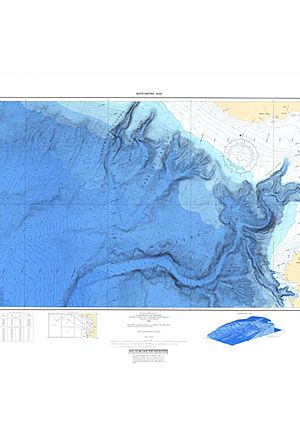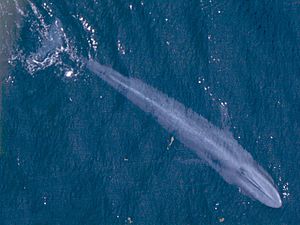Soquel Canyon State Marine Conservation Area facts for kids
The Soquel Canyon State Marine Conservation Area (SMCA) is a special ocean area in Monterey Bay, California. It's like an underwater park! Monterey Bay is on California's central coast, with the city of Monterey to the south and Santa Cruz to the north. This protected area covers about 23.41 square miles (60.63 square kilometers). In most of this area, it's against the rules to fish or take any living things from the ocean. However, people are allowed to fish for certain types of fish that swim in the open ocean, like tuna or sardines.
Contents
History of Soquel Canyon
Why Was This Area Protected?
The Soquel Canyon SMCA was created in September 2007 by the California Department of Fish & Game. It was one of the first 29 ocean areas protected in California. This happened because of something called the Marine Life Protection Act Initiative.
This initiative was a big effort to create a network of protected ocean areas all along California's coast. It brought together many people to help decide which parts of the ocean needed special protection. The goal was to keep our ocean healthy for the future.
Exploring the Canyon's Features
What Makes This Area Special?
The Soquel Canyon SMCA is unique because it includes a part of the amazing Monterey Submarine Canyon. Imagine a huge canyon, like the Grand Canyon, but underwater! This canyon is one of the deepest and largest in the world.
The SMCA protects a side branch of this massive underwater canyon. This means it has very deep parts with steep walls, just like a canyon on land.
Ocean Life in the Canyon
Who Lives in Soquel Canyon?
The Monterey Submarine Canyon is a fantastic home for many different ocean creatures. Its rocky walls and muddy, sandy floor are perfect places for various types of rockfishes. Some of these fish species need extra protection because their numbers have gone down.
Deep inside the canyon, you can find delicate deepwater corals and sponges. These are living animals, not plants, and they grow very slowly. The area is also a vital feeding spot for many seabirds and giant whales, who come here to find their food.
Fun Things to Do Near the Canyon
Visiting Monterey Bay's Attractions
The beautiful ocean and natural environment around the Monterey Peninsula attract millions of visitors every year. Many people come to dive, explore, and enjoy the ocean. Over 65,000 scuba divers visit the area because it's easy to access, has lots of wildlife, and features amazing kelp forests. Kelp forests are like underwater forests made of giant seaweed.
Monterey Bay Aquarium
A very popular place to visit is the Monterey Bay Aquarium. It has a huge exhibit that shows a living kelp forest, which is 28 feet (8.5 meters) deep! This exhibit features many of the same animals you might find in the nearby protected ocean areas. The aquarium also has playful sea otters, creatures from the tide pools, and sometimes even sea turtles.
Besides diving and visiting the aquarium, people love to go kayaking, whale watching, and surfing in Monterey Bay. It's also a great place for bird watching, exploring tide pools, and walking on the beach.
California's marine protected areas encourage people to enjoy and learn about the ocean. Activities like kayaking, diving, snorkeling, and swimming are usually allowed, unless there are specific rules against them in certain spots.
Studying the Ocean's Health
How Scientists Help the Canyon
Scientists are carefully watching some of California's marine protected areas, including those near Soquel Canyon. They want to see how well these protected areas are working and learn more about the health of our oceans.
Similar studies in other protected areas have already shown good results. For example, in areas off the Santa Barbara Channel Islands, scientists have seen fish growing larger and their numbers increasing over time.
Many local universities and research centers are involved in this important work. These include Stanford University’s Hopkins Marine Station, University of California Santa Cruz, Moss Landing Marine Laboratories, and Cal Poly San Luis Obispo. Scientists use different methods to study the ocean, such as fishing with hooks and lines, doing surveys while scuba diving, and even using special underwater robots called Remote Operated Vehicles (ROVs).



